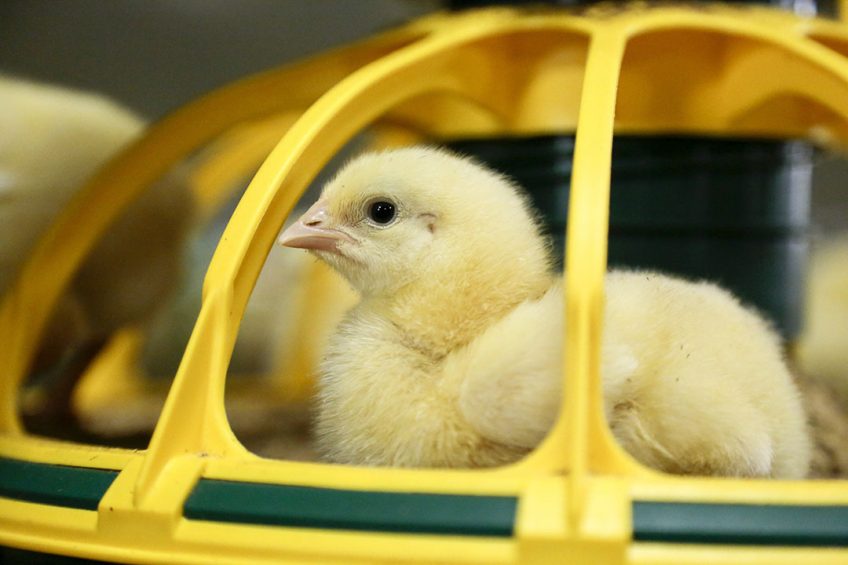How broiler feed complements performance

A broiler bird’s first seven days represents a quarter of its life, and the period at which growth is fastest. One nutritionist explains how important a role feed has to play in that performance, and some of the elements that make up diet formulation.
Achieving the genetic potential of broiler birds is a sure-fire way to improve farm profitability, but getting it right isn’t always straightforward. “We are now processing birds as early as 28 days,” according to senior nutritionist at UK compound feed manufacturer ABN Brian Kenyon. “Those seven days are 25% of that bird’s life, so it’s absolutely key that we get it right, and get birds off to the best start.” Chicks are placed weighing around 42g, and by 42 days will be “at least” 2.8kg, explains Mr Kenyon, making average daily liveweight gain 66g. But consider the first seven days, when the target weight is 189g – “that is a full fivefold increase in bodyweight and is the fastest rate at which the bird is going to grow.”
Potential
As such, it is also the period where the best gains can be made in growth, or the losses are greatest if it goes wrong. To top it off, in much of the world today, and certainly the UK, it routinely must happen without antibiotics, which were traditionally used at the beginning of the birds’ lives to guard against health issues and to support the bird’s growth. Mr Kenyon says there are three challenges that chicks face when placed on farm; a switch to aerial breathing, the beginning of thermal regulation and the transition in feed material, from the lipid-based yolk to compound feed, which is largely carbohydrate based. “The first two are about food house management,” explains Mr Kenyon. “The feed transition is a success when good house management meets good feed design, it’s not just one, it is both parts that have a key effect on how birds move on to this different diet.” Muscle development is determined by the proliferation of satellite cells, the numbers of which can be influenced by nutrition, brooding temperature and light – but cell numbers drop off between two- and three-days post hatch, and once they have dropped off, muscle cell number is fixed.
Intestinal growth and development
Bodyweight growth is impressive, but even faster is intestinal growth. “Immediately post-hatch the proportional growth of small intestines is greater than that of the bodyweight,” says Mr Kenyon. A big influence on that is time to feed. “Feed intake stimulates gut growth; it also starts and increases the rate of yolk sac utilisation. So, it’s key that when a bird starts to eat, it has continual access to feed, or we might run into problems.” And ensuring that feed is optimised for that growing gut is critical, says Mr Kenyon. “We’re trying to balance nutrition, because any excess will potentially be used by bad bacteria in the gut or is wasteful.” “Both of these can have a negative effect on bird health and litter condition in the house – it’s key we try and get feed design to the optimum balance.”
Feed design
Design comprises a range of elements, including ingredient quality, heat treatment, feeds’ physical form and any additives such as probiotics, prebiotics acids and anticoccidials. Starter feeds usually include wheat, barley or maize at different levels complemented with a protein source such as soyabean, rape or fishmeal, a small amount of an oil is included, and “maybe a small amount of sunflower depending on space, then you have got your minerals and vitamins topping up the diet.” But availability determines what is included in diets. “In an ideal world there are some raw materials I’d love to put in our starter feeds, but there aren’t the quantities available to use them on a commercial scale,” Mr Kenyon says “We also need to keep diets as consistent as possible.” Legislation plays a part, but so too does customer preferences. “We’re not allowed to use fish in some diets and are actively trying to remove palm oil for some customers.” And variability in crops must also be taken into account when balancing rations.
Anti-nutritional factors
“Plants didn’t design themselves to be eaten,” says Mr Kenyon. They contain components that hinder digestion. A wide range of processes take place to make feed as digestible as possible, including heat treatment, as well as the addition of additives such as feed enzymes to mitigate antinutritional elements in feed. In conclusion, Mr Kenyon says modern broilers have the genetic potential for rapid bodyweight gain in the first seven days, supported by and even more rapid growth and development in the intestinal tract. “We can achieve that challenge through good husbandry and house management and complementing that with a feed comprised of high-quality raw materials balanced in terms of energy protein to match the requirements of the production system.”
This report is based on a presentation delivered at the recent Northern Poultry Conference.
| Butyrate to reduce inflammation Mr Kenyon spoke of the value butyrate has in broiler diets, explaining they worked as a source of energy for the gut. “Butyrate is a fantastic product as far as I’m concerned,” he told the meeting. “It supplies a direct energy source to the gut so in that early stage when we potentially have this imbalance and want to be sure the gut is getting all the nutrients it requires, butyrate is a key energy source. It also helps and promotes mucus secretion. “It’s also in that feedback loop to inflammation – so when birds’ guts are being challenged, inflammation happens, which results in water loss, and you end up with wet litter. Butyrate is a key part there that helps to reduce inflammation.” |













